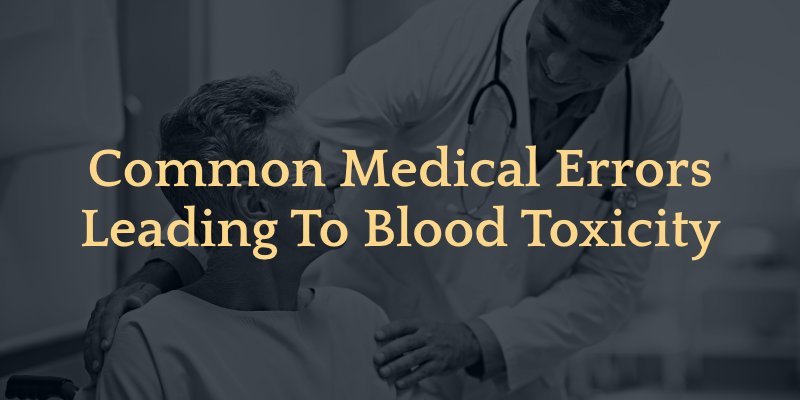No recovery • no fee
480.991.7677
scottsdale • phoenix
Common Medical Errors Leading to Blood Toxicity
Published on December 22, 2023
Doctors prescribe life-saving medications every day, including medications for temporary conditions or long-term daily use. Sadly, medical errors are a leading cause of death in the United States, including medication mistakes leading to blood toxicity. Because symptoms of drug toxicity may be subtle at first, these dangerous warning signs sometimes go unnoticed by patients and their doctors for some time, leading to further toxicity levels and serious or catastrophic results. Because medical providers sometimes fail to consider the medications taken by a patient and instead address their symptoms under the assumption that they’re from a new medical condition, they may fail to order tests and properly identify and promptly treat blood toxicity.

What is Blood Toxicity?
A drug’s toxicity refers to how dangerous the medication may become if there is too much of it in a person’s bloodstream. Drug toxicity is not the same as a drug overdose. A drug overdose occurs suddenly due to ingestion or injection of a dangerously high dosage of a drug or medication, while blood toxicity often happens over time due to an unintentional build-up of a medication in a patient’s bloodstream.
When dangerous medications accumulate in an individual’s bloodstream it leads to adverse effects on the liver, the brain, and other organs. The toxic effects of a drug may be dependent upon the dosage and may impact only specific organs like the liver or kidneys or could have system-wide impacts such as catastrophic effects on the brain and nervous system.
If a doctor recognizes symptoms of blood toxicity due to an accumulation or overdosage of medication, they can promptly address the problem through stomach pumping and counteractive medications. However, failure to accurately diagnose blood toxicity from medications can result in catastrophic injury or death.
For many medications, there is a narrow threshold between a dosage providing a therapeutic or beneficial effect and toxicity. In many cases, the threshold may vary between patients depending on their body weight, liver and kidney function, hydration level, and the other medications the person takes.
When doctors fail to promptly diagnose and treat blood toxicity, it’s an actionable medical error.
Types of Medical Mistakes Leading to Blood Toxicity
Even when a medication has beneficial, life-saving properties, or pain-mitigating effects, it can become a hazardous toxin when it over-accumulates in a patient’s body. Drug toxicity may occur due to over-ingestion, a too-high prescribed dosage, or adverse reactions. One commonly known example of blood toxicity occurs when patients regularly taking acetaminophen develop blood toxicity leading to liver damage.
Medical errors leading to cases of toxicity include the following:
- Doctor error: when a doctor prescribes the wrong medication, or wrong dosage, or leaves a patient on a medication for too long, it can result in toxic levels of the medication in the patient’s blood resulting in injury
- Failure to properly monitor a patient on a medication: If a patient’s weight changes significantly or they add new medications and a doctor fails to adjust a medication dosage appropriately, it may cause the medication to build up to a toxic level
- Pharmacy error: when pharmacists make a medication mistake by filling a prescription incorrectly either through the wrong medication or wrong dosage, it can cause blood toxicity in a patient leading to harmful impacts, brain damage, or death
- Anesthesia errors: blood toxicity from anesthesia medications may occur quickly when anesthesiologists administer an improper dosage or fail to adequately monitor patients. Adverse reactions such as lack of oxygen to the brain (hypoxia) may lead to brain damage, coma, or death
- Nursing home medication mistakes: nurses and caregivers are responsible for administering and monitoring patient medications. When caregivers in nursing homes make medication mistakes such as administering medications to the wrong patient or administering the wrong dosage, the results to elderly patients with weakened organ systems may be severe or catastrophic. Elderly patients are especially at risk since the symptoms of toxicity may be masked or dismissed as dementia or other age-related medical conditions
When toxic levels of medications build up in the bloodstream, the results to the patient may be catastrophic if not promptly recognized and addressed. Medication mistakes may occur due to a doctor’s repeated prescribing without performing thorough patient checks, doctor failure to monitor patient progress, failure to adequately warn patients of adverse effects, or pharmacy or dispensing errors.
Examples of Medication Mistakes Leading to Blood Toxicity
Medication errors are classified into four specific categories described below:
Knowledge-Based Errors
These occur when a doctor fails to gather all the necessary information such as a patient’s medication history. Examples include a doctor who prescribes a medication based on a patient’s previous weight without considering a recent weight loss.
Rule-Based Errors
This occurs when a doctor uses a bad rule or misuses a good rule, such as failing to properly pass on patient information between facilities.
Action-Based Errors
Action-based errors occur when a pharmacist or medical provider performs an incorrect action. An example occurs when a pharmacist misreads a doctor’s prescription or a medication label such as confusing Diltiazem for Diazepam.
Memory-Based Errors
These are lapses that occur when a doctor or caregiver forgets that they’ve already administered a patient’s medication and administers a second dose. This type of medication mistake occurs in nursing home environments and healthcare facilities and may lead to blood toxicity in patients or residents.
Signs and Symptoms of Blood Toxicity
It’s important to recognize the signs and symptoms of blood toxicity. Unfortunately, the symptoms vary widely depending on the type of medication that builds up in the patient’s bloodstream. Symptoms could include the following:
- Dizziness
- Nausea
- Diarrhea
- Stomach pain
- Tremors and other nervous system reactions
- Rash
- Sudden cardiac arrest
Some drug toxicities are reversible with discontinuation of the medication, but depending on the type of medication, others may have irreversible impacts on the patient.
Liability in Blood Toxicity Errors
Medical providers owe a special duty of care to patients. This duty requires them to treat their patients at the level of care that’s accepted by the medical community. When a doctor or other provider fails in this duty of care and their breach of duty directly causes damages to the victim, such as:
- Medical expenses
- Lost income, and
- Pain and suffering
- Wrongful death
The provider who caused the damages is liable for providing compensation through their medical malpractice insurance. In the event of a serious medical error, the Phoenix medical malpractice attorneys at Knapp & Roberts are prepared to help assess your legal options.
Let us tell your story
we care, and we can help. Contact us 480-991-7677 or fill out the form below
The personal injury attorneys in Phoenix, Arizona, at Knapp & Roberts have the compassion and trial lawyer skills to tell your story to a jury. We will get to know you and your family so that we can help the jury understand what has happened to you and your family and how it has changed your lives. Obtain the compensation necessary for the injuries and losses you have suffered.
Bob L. - "Mr. Knapp helped me with decisions I did not know how to deal with until he gave me excellent legal and medical consultation."

